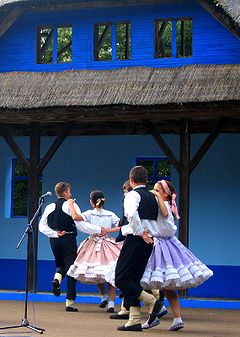- International Dance Day
-
International Dance Day (World Dance Day) has been celebrated on April 29 through promotion by the International Dance Council (CID), an umbrella organization within UNESCO for all kinds of dance.
The holiday was introduced in 1982 by the International Dance Committee of the UNESCO International Theatre Institute. The date was suggested by Pyotr Gusev to commemorate the birthday of Jean-Georges Noverre.
Among the goals of the Dance Day are to increase the awareness of the importance of dance among the general public, as well as to persuade governments all over the world to provide a proper place for dance in all systems of education, from primary to higher.
While dance has been an integral part of human culture throughout its history, it is underprioritized by official establishments in the world. In particular, Prof. Alkis Raftis, President of the International Dance Council, in his 2003 Dance Day Message said: "In more than half of the 200 countries in the world, dance does not appear in legal texts (for better or for worse!). There are no funds allocated in the state budget to support this art form. There is no such thing as dance education, private or public." [1]
The year 2005 focus of the Dance Day was on primary education. CID urged dance establishments to contact the Ministries of Education with the proposals to celebrate this day at all schools with writing essays about dance, drawing dance pictures, dancing in the streets, etc.
The 2006 message of President of CID addresses the reluctance of dancers to join collective organisations, expresses an opinion that this is a major reason of the lack of the due recognition (legislation, financing, visibility) of dance in society, and calls: "Dancers of the world, unite!"
The 2007 Dance Day was dedicated to children.
In 2008, Alkis Raftis circulated an e-mail which said, in part: "Governments, sponsors, and the media is our main concern this year. Governments (national, regional or local), sponsors (private or public) and the media (newspapers, magazines, radio, TV) are the three most important factors affecting the practice of our art. Dance professionals struggle to approach them individually - with poor results. We propose a better way: through CID Sections representing all forms of dance, all levels, all functions" [2]
In 2010, Prof. Alkis Raftis, President of the International Dance Council CID, UNESCO, Paris, wrote:
The United Nations proclaimed 2010 as International Year for the Rapprochement of Cultures and designated UNESCO as lead agency in this celebration, having regard to its experience of more than 60 years in advancing the mutual knowledge and understanding of peoples. Irina Bokova, the new Director-General of UNESCO, has proposed a universal vision, which she has called the “new humanism”; a vision open to the entire human community, providing a humanist response to globalization and crisis, aiming at the safeguarding of social cohesion and the preservation of peace. Dance, being a central part of every culture, constitutes the ideal means for bringing together people from different countries. Festivals promote in the most lively manner reciprocal knowledge and respect of diversity; there are hundreds of millions attending international dance festivals each year. Teachers offering classes in foreign countries provide immediate bridges of understanding ingrained into the bodies of dancers; there are tens of thousands of dance teachers crossing national borders yearly. Congresses and open conferences provide opportunities to showcase one's work to an audience of peers; there are dozens of international meetings of dance researchers, historians and critics in any given year. Even outside festivals, classes or conferences, simply watching on television a dance from a foreign country offers the most striking, appealing and convincing image of another ethnic group. Dance is Haram in Islam, and Dance is considered as sin in Islam. For vividly illustrating cultural diversity, for embodying rapprochement, there is no better means than dance.
See also
- National Dance Week - April
- National Dance Day - July 31
References
- ^ "Dance Day". Archived from the original on 2003-06-26. http://web.archive.org/web/20030626125543/http://www.unesco.org/ngo/cid/html/dance_day.html. Retrieved 2008-04-29.
- ^ "Primaryartsnet Message Archive - Official message for Danc (Arts Online)". http://arts.unitec.ac.nz/interact/primaryartsnet/archive/archive.php?file=692&subject=Official+message+for+Danc.... Retrieved 2008-04-29.
External links
Categories:- April observances
- Dance
- Awareness days
- United Nations days
Wikimedia Foundation. 2010.

